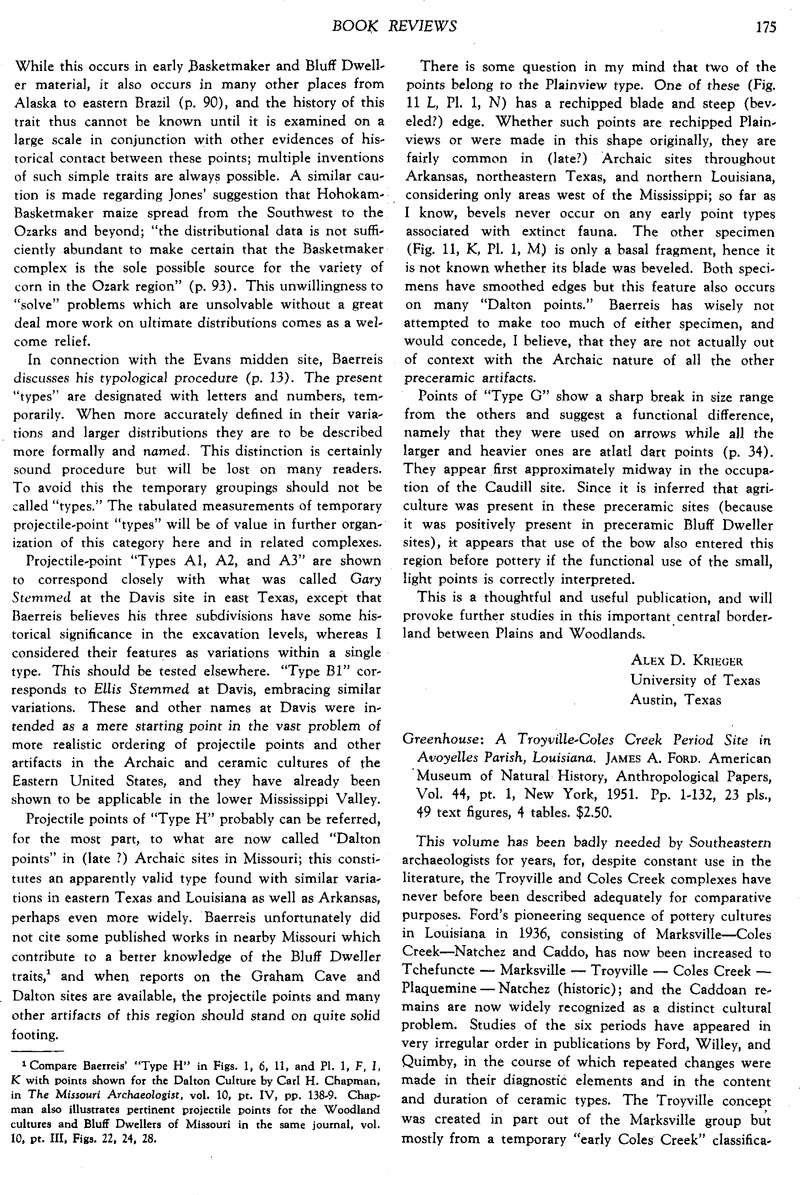Published online by Cambridge University Press: 25 January 2017

1 George I. Quimby, The Medora Site, West Baton Rouse Parish, Louisiana. Field Museum of Natural History, Anthropological Series, Vol. 24, No. 2, 1951.
2 John L. Cotter and John M. Corbett, Archaeology of the Bynum Mounds, Mississippi. National Park Service, Archaeological Research Series, No. 1. Washington, 1951 (reviewed by Philip Phillips in American Antiquity, Vol. 17, No. 4, April 1952; by J. D. Jennings in the American Journal of Archaeology, Vol. 56. No. 1, January, 1952).
3 John L. Cotter, “Stratigraphic and Area Tests at the Emerald and Anna Mound Sites,” American Antiquity, Vol. 17, pt. 1, pp. 18–32, 1951.
4 H. Perry Newell and Alex D. Krieger, The George C. Davis Site, Cherokee County, Texas, Society for American Archaeology Memoir 5, 1949.
5 Alex D. Krieger, “A Radiocarbon Date on the Davis Site,” American Antiquity, Vol, 17, pp. 144–5, 1951.
6 Philip Phillips, James A. Ford, and James B. Griffin, Archaeological Survey in the Loiver Mississippi Alluvial Valley, 1940–1947. Papers of the Peabody Museum, Harvard University, Vol. 25, 1951, pp. 304–5.
7 Ibid., PP. 454–5.
8 The Gahagan and Crenshaw mound groups are cited as examples of “Caddoan” sites which should show cultural exchange with Coles Creek if they were approximately contemporaneous. Gahagan is on the Red River about 100 miles northwest of Greenhouse, and Crenshaw 80 or 90 miles farther up, in Arkansas. Clarence H. Webb of Shreveport has in fact found Coles Creek, as well as Bossier and Belcher focus sherds, on the Gahagan site surface. Judge Lemley's work at Crenshaw requires a re-examination in view of present problems, for his important data on the “Caddo” graves there has never been published. His “Caddo” graves are of two very distinct types: those sunk through the Coles Creek graves were small, single interments with pottery of the Texarkana and Belcher focus complexes (Fulton aspect); but seven or eight others were huge multiple interments with the skeletons laid in neat rows, auite similar to those with Coles Creek pottery, except that their numerous vessels seem to combine features of the Alto, Gahagan, and Spiro foci. The time relationship of these large-grave complexes has not been established, but Judge Lemley plans to publish his data.
9 Newell and Krieger, op. cit., Fig. 4, p. 79, and Table 1.
10 This sherd was examined by Richard S. MacNeish, who remarked on its resemblance to the stamps on Illinois and Wisconsin Hopewellian pottery. A sherd strikingly like it is shown by W. C. McKern in “A Wisconsin Variant of the Hopewell Culture,” Bulletin, Public Museum of Milwaukee, Vol. 10, No. 2, 1931, PI. XLIV, fig. 8.
11 Newell and Krieger, op. cit., pp. 219–24 and 236–7.
12 Volney H. Jones, in Newell and Krieger, op. cit., p. 246. Phillips, Ford, and Griffin, op. cit., p. 454.